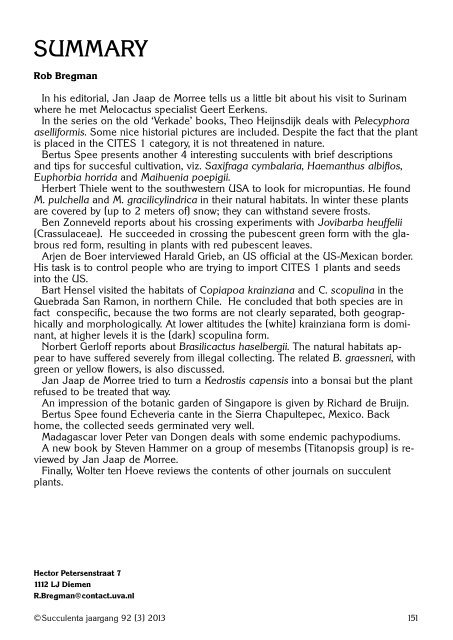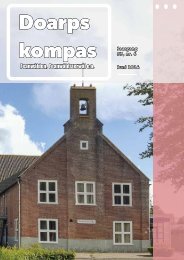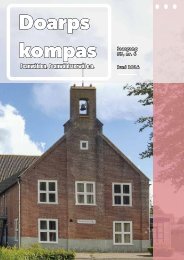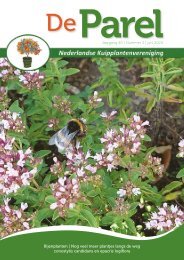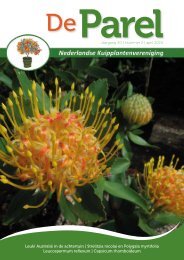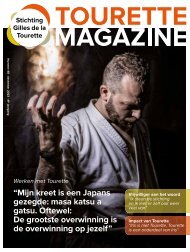- Page 2 and 3:
edactioneel Hardnekkig Henk Viscaal
- Page 4 and 5:
4 ©Succulenta jaargang 92 (1) 2013
- Page 6 and 7:
Mij doen de pantsercellen sterk den
- Page 8 and 9:
Afb. 6: De kleur van het bloemscher
- Page 10 and 11:
Afb. 9: C. ‘Morgan’s Beauty’
- Page 12 and 13:
VOOR HET VOETLICHT Bertus Spee Thel
- Page 14 and 15:
OP BEZOEK BIJ…..LUDWIG BERCHT Jan
- Page 16 and 17:
toenmalige redactieraad. Maar het b
- Page 18 and 19:
HET GESLACHT GYMNOCALYCIUM - EEN OV
- Page 20 and 21:
Afb. 2: G. gibbosum in Lemaire, Ico
- Page 22 and 23:
met een kale schedel. Op de areolen
- Page 24 and 25:
Afb. 10: G. reductum (WP 17-19) Cer
- Page 26 and 27:
Afb. 15: G. reductum subsp. leeanum
- Page 28 and 29:
HET GESLACHT COTYLEDON (10) Cotyled
- Page 30 and 31:
EEN PAAR OVERDENKINGEN BIJ HET GESL
- Page 32 and 33:
Afb. 7: N. vorwerkii (VZ 176), Mach
- Page 34 and 35:
want deze soort is deels zelffertie
- Page 36 and 37:
Afb. 2: C. nemorosa in Matjiesvlei
- Page 38 and 39:
Morfologische kenmerken zijn (steed
- Page 40 and 41:
zwemmen of vliegen.” Iets verder
- Page 42 and 43:
JOVIBARBA HEUFFELII ‘MAGIC CIRCLE
- Page 44 and 45:
Afb. 3: Geselecteerde Jovibarba heu
- Page 46 and 47:
wel het geval is. Aangeraden wordt
- Page 48:
Inlichtingen over het lidmaatschap,
- Page 67 and 68:
PARODIA HASELBERGII DE ROODGELE BES
- Page 69 and 70:
©Succulenta jaargang 92 (2) 2013 5
- Page 71 and 72:
onder zeer verschillende omstandigh
- Page 73 and 74:
Copiapoa humilis Een van de gemakke
- Page 75 and 76:
Afb. 1: De auto is nog net te zien
- Page 77 and 78:
Afb. 10: Agave albopilosa ©Succule
- Page 79 and 80:
van een wrak van een vastgelopen au
- Page 81 and 82:
Afb. 2: S. glomeriseta, één van d
- Page 83 and 84:
Afb. 6: Een nog kleine langbedoornd
- Page 85 and 86:
op de rotsige ondergrond in mos sta
- Page 87 and 88:
HET GESLACHT COTYLEDON (11) Cotyled
- Page 89 and 90:
Matucana weberbaueri zorgt voor ver
- Page 91 and 92:
AGAVEN IN PALERMO Ivana Richter Bij
- Page 93 and 94:
Afb. 2: Agave ragusae Terracc. in d
- Page 95 and 96:
tuin in Florence de plant tot bloei
- Page 97 and 98:
Afb. 11: Het wandelpad met Ceiba en
- Page 99 and 100:
Afb. 2: Kampeerplaats tussen de “
- Page 101 and 102:
Afb. 9: Indrukwekkende keien bij av
- Page 103 and 104:
loemknop die jammer genoeg voortijd
- Page 105 and 106:
eigenschappen bezit: 1 - Leem is er
- Page 107 and 108:
eigenschap (“Vocht verspreidt zic
- Page 109 and 110:
SUCCULENTENNIEUWTJES Wolter ten Hoe
- Page 111 and 112:
Summary Rob Bregman Wolter ten Hoev
- Page 130 and 131:
Redactioneel Jan Jaap de Morree Bij
- Page 132 and 133: Afb. 2: De eerste afbeelding van P.
- Page 134 and 135: ander gebruikt. In Mexico staat de
- Page 136 and 137: Afb. 6: De bloemknoppen zijn omgeve
- Page 138 and 139: Voor het voetlicht Bertus Spee Saxi
- Page 140 and 141: Op zoek naar cactussen uit het gesl
- Page 142 and 143: Afb. 7: Escobaria vivipara op de gr
- Page 144 and 145: Afb. 14: Bloem M. gracilicylindrica
- Page 146 and 147: Afb. 16: Astragalus crotalariae Bes
- Page 148 and 149: Afb. 1: Groene en behaarde Jovibarb
- Page 150 and 151: De Amerikaans/Mexicaanse grens in E
- Page 152 and 153: Toen ik in 1985 mijn carrière bego
- Page 154 and 155: continentaal Amerika en Hawaï, waa
- Page 156 and 157: de bestuurder en ze waren op weg na
- Page 158 and 159: cactuskwekerij, die jaren geleden C
- Page 160 and 161: Afb. 2: Twee extreme C. scopulina-v
- Page 162 and 163: Afb. 6: Zaailingen, op de voorgrond
- Page 164 and 165: Afb. 2: Cultuurplanten van N. hasel
- Page 166 and 167: IN THE PICTURE Groeizame bonsai Jan
- Page 168 and 169: ONVERWACHTE ONTDEKKING IN SINGAPORE
- Page 170 and 171: Afb. 3: Flower Dome (links) Cloud F
- Page 172 and 173: Sierra Chapultepec Bertus Spee Aan
- Page 174 and 175: en is de zoveelste geslaagde missie
- Page 176 and 177: DE PACHYPODIUMS IN ZUID-MADAGASKAR
- Page 178 and 179: de soorten Pachypodium succulentum,
- Page 180 and 181: Boekbespreking: Steven A. Hammer. M
- Page 184: Inlichtingen over het lidmaatschap,
- Page 195 and 196: EUPHORBIA GRANDICORNIS: DE GROOTDOO
- Page 197 and 198: Na Von Goebel in 1889 is het stil t
- Page 199 and 200: van de in etages groeiende stengels
- Page 201 and 202: Hechtia lyman-smithii Ook deze mooi
- Page 203 and 204: 1. Echinocactus crassihamatus F.A.C
- Page 205 and 206: Afb. 2: De bloem van Ancistrocactus
- Page 207 and 208: de originele artikelen van Britton
- Page 209 and 210: gevormd door een aaneenschakeling v
- Page 211 and 212: grijsblauwe laag die gevormd is als
- Page 213 and 214: apart geslacht, maar David Hunt erk
- Page 215 and 216: A B Afb. 3a en b: T. hoferi a. meel
- Page 217 and 218: Afb. 11: T. krainzianus na aanrakin
- Page 219 and 220: Crassula barklyi is afkomstig uit Z
- Page 221 and 222: voormalige verzameling van de eerst
- Page 223 and 224: a van Volmoed RSA in 1892 ontdekte.
- Page 225 and 226: Afb.7: Cotyledon orbiculata van Gra
- Page 227 and 228: EEN GELUKSTREFFER Leo Busch Een kle
- Page 229 and 230: Afb. 3: Afb. 4: Afb. 5: Afb. 6 Afb.
- Page 231 and 232: TRIPSEN Louis Van de Meutter Tripse
- Page 233 and 234:
meer M. haudeana, en echinocereusse
- Page 235 and 236:
SUCCULENTENNIEUWTJES Wolter ten Hoe
- Page 237 and 238:
Thelocactus bicolor var. commodus e
- Page 239 and 240:
Summary Rob Bregman In my editorial
- Page 241 and 242:
Nederlands Belgische vereniging van
- Page 243 and 244:
ALGEMENE LEDENVERGADERING Notulen A
- Page 245 and 246:
Het voltallige bestuur; v.l.n.r. Mi
- Page 247 and 248:
Een aantal beheerders van instellin
- Page 249 and 250:
JAARVERSLAG VAN DE SECRETARIS Nadat
- Page 251 and 252:
INSTELLINGEN VERENIGINGSARTIKELEN B
- Page 253 and 254:
IN MEMORIAM In memoriam Jaap van To
- Page 255 and 256:
Nederland NIEUWE LEDEN MEI - JUNI 2
- Page 258 and 259:
Nederland regenland? Ben Zonneveld
- Page 260 and 261:
nartjie of nartje is een kleine cit
- Page 262 and 263:
Afb. 5: Crassula columella (= klein
- Page 264 and 265:
Voor het voetlicht Bertus Spee Fero
- Page 266 and 267:
Tephrocactus alexanderi Ton Pullen
- Page 268 and 269:
Tridentea gemmiflora Louis Van de M
- Page 270 and 271:
Afb. 4: T. gemmiflora, donkere bloe
- Page 272 and 273:
DE PLANTENTUIN UNIVERSITEIT GENT Is
- Page 274 and 275:
de zwepenboom (Celtis occidentalis)
- Page 276 and 277:
planten waaronder een mooie collect
- Page 278 and 279:
EEN BEZOEK AAN CHIRICAHUA NATIONAL
- Page 280 and 281:
het “Inspiration Rock Trail” of
- Page 282 and 283:
Afb. 10: E. santaritensis in Corona
- Page 284 and 285:
Het maken van een rode minivorm van
- Page 286 and 287:
Zaadfotografie en enkele consequent
- Page 288 and 289:
Afb. 3. Zaad van S. arenacea WR460
- Page 290 and 291:
Afb. 7. Zaad van Rebutia xanthocarp
- Page 292 and 293:
Afb.2: Dennis Lodder in de VU hortu
- Page 294 and 295:
Afb.5: Mooi volgroeide melocactusse
- Page 296 and 297:
Afb. 8: Een zeer forse Gymnocalyciu
- Page 298 and 299:
zorgvuldig tussen mijn kleren in de
- Page 300 and 301:
zaden kunnen ontkiemen tot een jaar
- Page 302 and 303:
kader van het commercialiseren van
- Page 304 and 305:
Inlichtingen over het lidmaatschap,
- Page 306 and 307:
ADRESSEN BESTUUR Voorzitter: W. Bac
- Page 308 and 309:
NOTULEN BESTUURSVERGADERING Verkort
- Page 310 and 311:
JUBILEA 2013 50-jarig Nijmeijer, H.
- Page 312 and 313:
In de ruimte waar ook Gerrit Melis
- Page 314 and 315:
KLIKOSTICKER enorme aantrekkingskra
- Page 316 and 317:
IN MEMORIAM FOPPE BROLSMA Ons berei
- Page 318 and 319:
AFDELINGSACTIVITEITEN 2013 AFDELING
- Page 320:
72 Verenigingsnieuws Succulenta Jaa
- Page 323 and 324:
EUPHORBIA OBESA: DE DIKKE WOLFSMELK
- Page 325 and 326:
ons land was de soort in 1924 voor
- Page 327 and 328:
Afb. 4: E. obesa ssp. symmetrica du
- Page 329 and 330:
Verder is er de obesa met wanstalti
- Page 331 and 332:
Afb. 15: Na een stuk of 20 ribben g
- Page 333 and 334:
Mammillaria crucigera Dit is een pl
- Page 335 and 336:
Sindsdien hadden lobivia’s voor m
- Page 337 and 338:
eyriesii, (maar waarvan Geert Eerke
- Page 339 and 340:
esultaat een groot aantal duidelijk
- Page 341 and 342:
Afb. 1: Panorama Calatrava moois te
- Page 343 and 344:
van planten. De succulenten groeien
- Page 345 and 346:
mogelijk te maken, zowel in natuurl
- Page 347 and 348:
conservatiedoeleinden. Hierbij is v
- Page 349 and 350:
ECHINOCACTUS HORIZONTHALONIUS Henk
- Page 351 and 352:
Afb. 3: Echinocactus horizonthaloni
- Page 353 and 354:
Afb. 7: Plant met platte bedoorning
- Page 355 and 356:
VREEMDE DOORNS IN DE HOBBYKAS Jan d
- Page 357 and 358:
ARCHES - OM NOOIT MEER TE VERGETEN
- Page 359 and 360:
nde rotsformaties voor zijn natuurl
- Page 361 and 362:
OP BEZOEK BIJ… GEERT EERKENS Jan
- Page 363 and 364:
Afb.5: Geert Eerkens wijst naar de
- Page 365 and 366:
naar geleverde prestatie, werden do
- Page 367 and 368:
Boekbespreking Henk Viscaal A Galle
- Page 369 and 370:
de ontdekking, nieuwbeschrijving, n
- Page 371 and 372:
Register Jaargang 92 (2013) Artikel
- Page 373 and 374:
Index van afbeeldingen van planten
- Page 375 and 376:
N Neowerdermannia chilensis .......
- Page 377 and 378:
©Succulenta jaargang 92 (6) 2013 2
- Page 379 and 380:
©Succulenta jaargang 92 (6) 2013 2
- Page 381 and 382:
©Succulenta jaargang 92 (6) 2013 2
- Page 383 and 384:
©Succulenta jaargang 92 (6) 2013 2
- Page 385 and 386:
Clichéfonds Zaadlijst 2013 - 2014
- Page 387 and 388:
WIJZE VAN BESTELLEN Bestellen via d
- Page 389 and 390:
A.capricorne) x (A.ast. sk) 15 L 1
- Page 391 and 392:
2 H 1 adustus (20zzp) kamvormige aa
- Page 393 and 394:
3 L 1 alegratana (20zzp) 4 L 1 aste
- Page 395 and 396:
Argentinië. In de laatste jaren is
- Page 397 and 398:
Bestelling van: Dhr/Mevr./Mej: : ..
- Page 399 and 400:
Bestelling van: Dhr/Mevr./Mej: : ..
- Page 401 and 402:
33 L 1 lemairei (20zzp) PCO 4013-01
- Page 403 and 404:
28 L 1 schlosseri (20zzp) 29 H 1 sc
- Page 405 and 406:
TOU Toumeya Tegenwoordig ook bij Pe
- Page 407 and 408:
19 L 1 rufescens (20zzp) 20 L 1 sp
- Page 409 and 410:
ten. Deze bladsucculenten zijn zode
- Page 411:
GEMENGDE ZAden MIX C01 Cactus zaden


